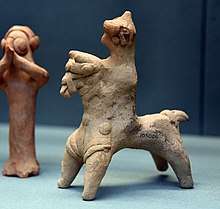Euphrates Handmade Syrian Horses and Riders
The Euphrates Handmade Syrian Horses and Riders (EU_HSHR's ) are zoomorphic clay figurines representing both solely horses or horses provided with riders and dating from the late Iron Age period (mid 8th–7th centuries BCE). These figurines are produced in the Middle Euphrates region and they belong to a production comprehending some anthropomorphic specimens, i.e. the Euphrates Syrian Pillar Figurines (EU_SPF's).

EU_HSHR from Karkemish. The British Museum, London, no. 105006.
Other names in literature
The actual nomenclature adopted for this class of figurines has been recently proposed in a doctoral research.[1] Their current name recalls their geographic origin, the manufacturing technique, and the portrayed subjects. However, one may find their appearance in literature with different nomenclatures:
Museums collections
Notes
- Bolognani, B. 2017, pp. 45,177.
- Moorey, P.R.S 1980, pp. 100–102; 2005, pp. 225, 228.
- Pruss, A. 2010, pp. 231–246.
- Clayton, V. 2001; 2013, pp. 13, 25–38.
- Padovani, C. 2019, p. 82, fig. 36.
- Bolognani, B. 2017, cat. no. 835
- Bolognani, B. 2017, cat. nos. 799–803.
- Ornan, T. 1986, pp. 46, 62 left
gollark: I caught a Black Truffle before realising it wasn't valuable enough to trade for stuff I actually want. If anyone wants it, ask and I'll send it in the morning (GMT+0). You'll need to set up a teleport yourself as my one magi is on cooldown.
gollark: !pr pass 69
gollark: No u.
gollark: !propose Add a new rule %9ee6f60faf321bbd6d56904fe70fe4c5:> Proposal 70 is considered open on any prime-numbered day of the month.
gollark: Hi!
References
- Bolognani, B. 2017, The Iron Age Figurines from Karkemish (2011–2015 Campaigns) and the Coroplastic Art of the Syro-Anatolian Region, unpublished doctoral dissertation, University of Bologna, Bologna. amsdottorato.unibo.it/8222/7/Bolognani_Barbara_tesi.pdf
- Clayton, V. 2001. Visible Bodies, Resistant Slaves: Towards an Archaeology of the Other: The 7th Century Figurines from Tell Ahmar, unpublished doctoral dissertation, University of Melbourne, School of Fine Arts, Classical Studies and Archaeology, Melbourne.
- Clayton, V. 2013. Figurines, Slaves and Soldiers. The Iron Age Figurines from the Euphrates Valley, North Syria, K&H Publishing, Victoria.
- Moorey P.R.S. 1980, Cemeteries of the First Millenium B.C. at Deve Huyuk, near Carchemish. Salvaged by T.E. Lawrence and C.L. Woolley in 1913 (with a catalogue raisonne of the objects in Berlin, Cambridge, Liverpool, London and Oxford)(«BAR» 87), Bar Publishing, Oxford.
- Moorey P.R.S. 2005, Ancient Near Eastern Terracottas: With a Catalogue of the Collection in the Ashmolean Museum, Ashmolean Museum, Oxford.
- Ornan, T. 1986, A Man and His Land, Highlights from the Moshe Dayan Collection (Israel Museum Catalogue 270), The Israel Museum, Jerusalem.
- Padovani, C. 2019, "36.Cavalier", in Blanchard, V. (ed.), Royaumes oubliés. De l'empire hittite aux Araméens, Liénart, Musée du Louvre, Paris, p. 82.
- Pruss A. 2010, Die Amuq-Terrakotten. Untersuchungen zu den Terrakotta-Figuren des 2. und 1. Jahrtausends v.Chr. aus dem Grabungen des Oriental Institute Chicago in der Amuq-Ebene,(Subartu 26), Brepols, Turnhout.
This article is issued from Wikipedia. The text is licensed under Creative Commons - Attribution - Sharealike. Additional terms may apply for the media files.